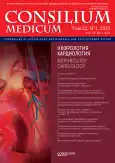Acute ST-segment elevation myocardial infarction in COVID-19 patients: a single hospital experience
- Authors: Safaryan V.I.1, Savostyanov K.A.1,2, Sizgunov D.S.1, Sargsyan A.Z.1, Birukov P.A.1
-
Affiliations:
- City Clinical Hospital №51
- Russian Medical Academy of Continuous Professional Education
- Issue: Vol 23, No 1 (2021)
- Pages: 43-47
- Section: Articles
- URL: https://journals.rcsi.science/2075-1753/article/view/95407
- DOI: https://doi.org/10.26442/20751753.2021.1.200574
- ID: 95407
Cite item
Full Text
Abstract
Keywords
Full Text
##article.viewOnOriginalSite##About the authors
Vakhtang I. Safaryan
City Clinical Hospital №51
Email: vahtang1985@yandex.ru
врач Moscow, Russia
Kirill A. Savostyanov
City Clinical Hospital №51; Russian Medical Academy of Continuous Professional Educationканд. мед. наук, доц., зав. отд-нием Moscow, Russia
Dmitry S. Sizgunov
City Clinical Hospital №51врач Moscow, Russia
Artur Z. Sargsyan
City Clinical Hospital №51врач Moscow, Russia
Petr A. Birukov
City Clinical Hospital №51врач Moscow, Russia
References
- Metzler B, Siostrzonek P, Binder RK, et al. Reinstadler Decline of acute coronary syndrome admissions in Austria since the outbreak of COVID-19: the pandemic response causes cardiac collateral damage. Eur Heart J 2020; 41 (19): 1852-3.
- Garcia S, Albaghdadi MS, Meraj PM, et al. Reduction in ST-Segment Elevation Cardiac Catheterization Laboratory Activations in the United States During COVID-19 Pandemic. J Am Coll Cardiol 2020; 75 (22): 2871-2.
- Picano E. Where have all the myocardial infarctions gone during lockdown? The answer is blowing in the less-polluted wind. Eur Heart J 2020; 41 (23): 2146-7.
- Crea F, Libby P Acute coronary syndromes: The way forward from mechanisms to precision treatment. Circulation 2017; 136 (12): 1155-66.
- Bikdeli B, Madhavan MV, Jimenez D, et al. COVID-19 and Thrombotic or Thromboembolic Disease: Implications for Prevention, Antithrombotic Therapy, and Follow-Up: JACC State-of-the-Art Review. J Am Coll Cardiol 2020; 75 (23): 2950-73.
- Tam CCF, Cheung K-S, Lam S, et al. Impact of Coronavirus Disease 2019 (COVID-19) Outbreak on ST-Segment-Elevation Myocardial Infarction Care in Hong Kong, China. Circ Cardiovasc Qual Outcomes 2020; 13 (4): e006631.
- Maron BJ. The paradox of exercise. New Engl J Med 2000; 343 (19): 1409-11.
- Lelieveld J, Klingmuller K, Pozzer A, et al. Cardiovascular disease burden from ambient air pollution in Europe reassessed using novel hazard ratio functions. Eur Heart J 2019; 40 (20): 1590-6.
- Li YC, Bai WZ, Hashikawa T The neuroinvasive potential of SARS-CoV2 may play a role in the respiratory failure of COVID-19 patients. J Med Virol 2020; 92 (6): 552-5.
Supplementary files






